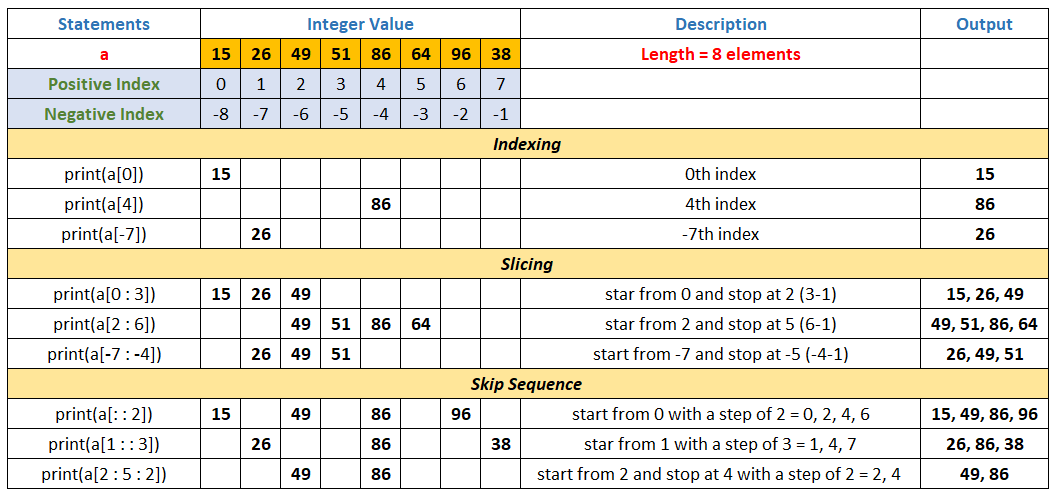Tuples in Python Programming
Data Structures in Python
In this lesson, we will understand what is Tuple in Python Programming along with some examples.
What is Tuple in Python?
A Tuple in Python is an immutable sequence. A Tuple is similar to a list, but one major difference between tuple and list is that a tuple is immutable but, a list is mutable. It means that we cannot change the element in tuple once it is defined.
Declaration Syntax of a Tuple in Python
tuple_name = (elements1,element2,...)Example
a = (5,8,6,2,9) # A tuple with five elements in itCreating an Integer Type Tuple
A python program to show how to create and display an integer type tuple in python.
Example
a=(15,2,49,51,86)
# printing the elements from an integer type tuple
for x in a:
print(x)Output
15 2 49 51 86
Creating a Floating Point Number Type Tuple
A python program to show how to create and display a floating point number type tuple in python.
Example
a=(18.23,24.11,564.2369,44.17,98.513)
# printing the elements from a floating point number type tuple
for x in a:
print(x)Output
18.23 24.11 564.2369 44.17 98.513
Creating a Character Type Tuple
A python program to show how to create and display a character type tuple in python.
Example
a=('a','e','i','o','u')
# printing the elements from a character type tuple
for x in a:
print(x)Output
a e i o u
Creating a String Type Tuple
A python program to show how to create and display a string type tuple in python.
Example
a=('apple','ball','cat','dog','eagle')
# printing the elements from a string type tuple
for x in a:
print(x)Output
apple ball cat dog eagle
Creating a Tuple of Different Types of Elements
A python program to show how to create and display a tuple of different types of elements in python.
Example
a=(15,'Henry','2A',56,81,74,70.33,'B')
# printing the elements from a tuple having different types of elements
for x in a:
print(x)Output
15 Henry 2A 56 81 74 70.33 B
Create Tuples from Existing Sequences
A python program to show how to create tuples from existing sequences. A sequence can be any kind of sequence including string, tuples and lists.
Example
str='Python' # A String
name=['Allen','Peter','Henry','Stephen'] # A List
t=(12,89,63) # A Tuple
T1=tuple(str) # Creating a tuple from a String
T2=tuple(name) # Creating a tuple from another List
T3=tuple(t) # Creating a tuple from a Tuple
print(T1)
print(T2)
print(T3)Output
('P', 'y', 't', 'h', 'o', 'n')
('Allen', 'Peter', 'Henry', 'Stephen')
(12, 89, 63)
Tuple Slicing
Tuple slicing is the process of accessing a part of the tuple using either positive or negative indexing with the help of tuple slicing syntax given below.
tuple_name[ start : end+1 : step]
Example
a=(15,26,49,51,86,64,96,38)
print(a[0])
print(a[4])
print(a[-7])
print(a[0:3])
print(a[2:6])
print(a[-7:-4])
print(a[::2])
print(a[1::3])
print(a[2:5:2])Output
15 86 26 (15, 26, 49) (49, 51, 86, 64) (26, 49, 51) (15, 49, 86, 96) (26, 86, 38) (49, 86)
Joining Tuples
We can use the concatenation operator + to join two tuples and returns the concatenated tuple as shown below.
Example
a=(15,2,49,51,86)
b=(56,8,97,4)
c=a+b
print(a)
print(b)
print(c)Output
(15, 2, 49, 51, 86) (56, 8, 97, 4) (15, 2, 49, 51, 86, 56, 8, 97, 4)
Use of Membership Operator in Tuple
Both in and not in operators works on Tuple just like they work for other sequences such as strings and lists. The in operator tells if an element is present in the tuple or not and not in does the opposite. See the example given below.
Example
a=(15,2,49,51,86)
print(a)
if (49 in a) == True:
print('49 is prenest in the tuple')
else:
print('49 is not prenest in the tuple')
if (70 not in a) == True:
print('70 is not prenest in the tuple')
else:
print('70 is prenest in the tuple')Output
(15, 2, 49, 51, 86) 49 is prenest in the tuple 70 is not prenest in the tuple
Tuple Methods
Tuple methods in Python are a collection of useful functions used to perform a specific task on a tuple. Let's see all the important tuple methods one by one with examples.
count() Method
The count() method returns the number of occurrences of a specified element in an existing tuple.
Example
a=(11,9,26,34,26,84,97,26)
print('Original Tuple: ',a)
print('Total occurrence of element 26: ',a.count(26))Output
Original Tuple: (11, 9, 26, 34, 26, 84, 97, 26) Total occurrence of element 26: 3
index() Method
The index() method returns the index of the first occurrence of the specified element in an existing tuple. The index() method raise ValueError if the element is not found.
Example
a=(11,9,26,34,26,84,97,26)
print('Original Tuple: ',a)
print('Index of first occurrence of element 26: ',a.index(26))Output
Original Tuple: (11, 9, 26, 34, 26, 84, 97, 26) Index of first occurrence of element 26: 2
Functions to Process Tuples
There are some useful functions available in python that we can apply on a tuple. The difference between Function and Method is that a Function is called directly with its name but a Method is called on objects only.
Let's see the functions given below with examples.
max() Function
The max() function returns the biggest element in a tuple.
Example
a=(11,91,57,34,26,97,63,18)
print('Tuple: ',a)
print('Biggest element is :',max(a))Output
Tuple: (11, 91, 57, 34, 26, 97, 63, 18) Biggest element is : 97
min() Function
The min() function returns the smallest element in a tuple.
Example
a=(11,9,57,34,5,97,63,10)
print('Tuple: ',a)
print('Smallest element is :',min(a))Output
Tuple: (11, 9, 57, 34, 5, 97, 63, 10) Smallest element is : 5
len() Function
The len() function returns the total numbers of elements present in a tuple.
Example
a=(11,91,57,34,26,97,63,18)
print('Tuple: ',a)
print('Total number of elements :',len(a))Output
Tuple: (11, 91, 57, 34, 26, 97, 63, 18) Total number of elements : 8
Iterate all Elements in a Tuple using range() Function
We can also iterate all elements in a tuple using range() function as shown below.
Example
a=(15,2,49,51,86)
# printing the elements from an integer type tuple
for i in range(0,len(a)):
print(a[i])Output
15 2 49 51 86
Nested Tuple
A tuple within another tuple is known as Nested Tuple. We can use nested tuple to create matrix in python. See the examples of nested tuple given below.
Example
A python program to show how to create a nested tuple to store the roll and names and age of three candidates.
a=((1,'Allen',15),(2,'Peter',17),(3,'Stephen',16))
# printing the entire tuple
print(a,'\n')
# printing the tuple row by row
for r in range(3):
for c in range(3):
print(a[r][c],end=' ')
print()Output
((1, 'Allen', 15), (2, 'Peter', 17), (3, 'Stephen', 16)) 1 Allen 15 2 Peter 17 3 Stephen 16
We can assume the above nested tuple as shown in the image below.

We can access any cell of a nested tuple using the following syntax.
tuple_name = [row_index][column_index]In the above program, we have run a nested for loop to access all the elements of the nested tuple. When the value of outer for loop r is 0, then the inner for loop c runs from 0 to 2 and prints all the elements of the first row of the nested tuple.
When the value of outer for loop r is 1, then again the inner for loop c runs from 0 to 2 and prints all the elements of the second row of the nested tuple and in the same way it prints the third row also.



